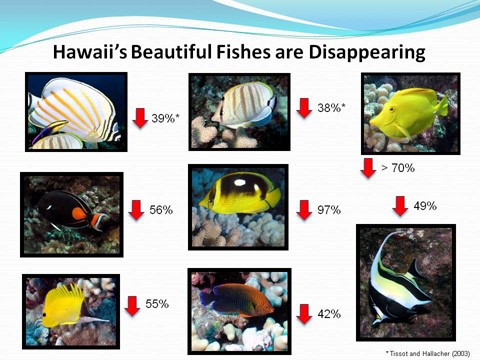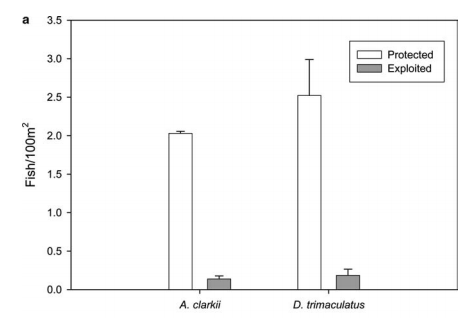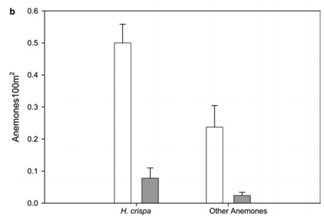Do you remember those mesmerizing aquariums that decorated the walls of the dentist’s office? The multitude of vibrantly hued fish and coral are nothing less than captivating. But where did those fish and coral come from? Behind aquariums’ exotic exterior is a distressing tale of coral reef damage. While the aquarium trade has bolstered the economy of many countries, mainly in coastal communities, its detrimental effects on coral reef health is nonetheless concerning.
First, I should explain what exactly the aquarium trade is and how it relates to coral reefs. The global aquarium trade harvests and transports marine ornamentals such as reef fish, invertebrates, and coral. A rapidly expanding enterprise, it was estimated to garner a global import value of around US $200-330 million in 20055. A possible reason for its increasing popularity over the past few decades could be due to influence from media like Pixar’s 2003 movie Finding Nemo3. Many children yearned for a Dory or Nemo of their own after watching that adventure! Coral reef organisms are sold to consumers mainly in the U.S, followed by Japan and Europe1. The most recent estimates peg the trade as dealing with over 150 species of stony corals, hundreds of species of non-coral invertebrates, and at least 1,472 reef fish species from 50 families3. However, it is also important to note that there are large discrepancies between governmental statistics of imported species and what many scientists believe are the actual statistics2.
Although the aquarium trade is not as pressing as global warming on coral reef decline, it is especially concerning in countries in the Coral Triangle (like the Philippines, Solomon Islands and Indonesia), where collection is heavily concentrated1. A few places outside of the Coral Triangle are also being pressured by the demands of the industry. For example, largely all fish species collected in Hawaii are now classified as endemic and suffering from significant population declines as shown by the graphic below.

Fig.1. Showcases the large scale fish species population decline in Hawaii.
Source: http://uhbiology.kahikai.org/?p=672
Several critical effects of the aquarium trade include:
- Disruption of reproductive cycle by taking out colorful males during reproductive season2.
- Interruption of coral reef food chain2.
- Habitat alterations2.
- Transportation of different species across borders lead to issues with invasive species1.
- Decimation of species populations beyond recovery due to specifically targeting popular species in commercial trade2.
Fish are selectively removed based on their color and size, with species that range from 2-9 centimeters being the most popular2. For instance, the Yellow Tang, which has made up a large majority of the fish caught in the industry, has suffered a sharp decrease in numbers5. This removal of species then sets up a domino effect where biodiversity on the reef as a whole is reduced as some species cannot survive without another.

The Yellow Tang, a popular and heavily collected reef fish species.
Source: http://animalia-life.club/fishes/yellow-tang.html
In order to see how the removal of one species may affect another, let’s examine a study on aquarium fishing’s effect on anemone and anemone fish (popular reef organisms for collectors) in Cebu, Philippines. In this study, researchers found that removal of anemones strongly correlated with a declining population of anemone fish, as the vast majority of anemone fish are symbiotic with host anemone species. Low density of anemones accounted for over 80% of the reduced density of anemone fish in exploited areas4.
Researchers began their study by classifying sites into “protected” and “unprotected,” with unprotected sites being where there are extensive fishing activities. The researchers used fishery logbooks and free swim census techniques to quantify the number of anemone and anemone fish in all the sites. The results were startling. As seen below in Figures 2 and 3, the densities of anemone fish species and host anemones strongly correlated with each other and were significantly higher in protected sites when compared to unprotected sites4. The study concludes that aquarium fishing activities drastically influenced the decline of anemone and anemone fish.
Fig 2&3. Graph on top depicts two anemonefish species’ (A. clarkii and D. trimaculatus, n=448) densities in protected and exploited sites. Gray is exploited and white is protected. Graph on bottom depicts host anemone species’ (H. crispa and others n=98, protected n=2, exploited n=3) densities in protected and exploited sites. Notice the strong correlation between anemonefish and host anemone densities. Source: Shuman, C.S., Hodgson, G. & Ambrose, R.F. Coral Reefs (2005) 24: 564. ProQuest, doi:10.1007/s00338-005-0027-z
This shows how taking out one reef species can influence the decline of another. Therefore, aquarium trade collecting have the potential to not only deplete the species they are collecting, but also other species that may depend on the one being removed.
Now more than ever, the magnificent beauty, resources, and biodiversity of coral reefs are in danger of disappearing forever. Because of their immense resources and scientific importance, as well as their role in the global economy, it is of utmost importance that we do all we can to preserve them. With the U.S being a major player in the global aquarium trade, it is crucial for us to understand the environmental cost of our aesthetic desires. Since aquarium exports are an integral part of the economy, especially for tropical countries like the Philippines and Indonesia2, it would be ill-advised to stop it entirely. However, the techniques we use in collecting reef organisms and implementing trade regulations can help lessen the negative impacts of the aquarium trade. These ideas will be discussed in further detail in future posts. Stay tuned for more information on the aquarium trade and coral reefs and what YOU can do to make a difference!
References:
1Rhyne, A. L., Tlusty, M. T., Schofield, P. J., Morris, J. A., Jr., & Bruckner, A. W. (2012). Revealing the Appetite of the Marine Aquarium Fish Trade: The Volume and Biodiversity of Fish Imported into the United States. PLOS ONE, 7(5). doi:10.1371/journal.pone.0035808
2Aquarium Trade Impacts. (n.d.). Retrieved February 21, 2017, from http://www.forthefishes.org/Aquarium_Trade_Impacts.html
3Prosek, J. (2010) Beautiful Friendship. Nat Geo Mag 217: 120–124.
4Shuman, C.S., Hodgson, G. & Ambrose, R.F. Coral Reefs (2005) 24: 564. ProQuest, doi:10.1007/s00338-005-0027-z
5Kai, Kahi. “UH Biology.” UH Biology RSS. UH Biology, 14 Mar. 2012. Web. 21 Feb. 2017.



